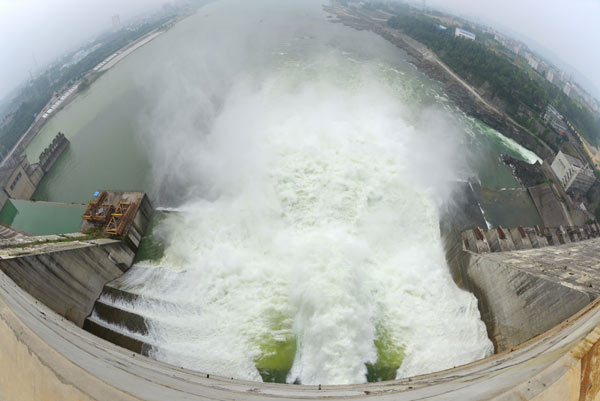Government taking measures to meet standard for quality
Authorities are struggling to improve the water quality in the middle route of the South-to-North Water Diversion Project, while progress on pollution controls has already been made two years ahead of a deadline in 2014.
The project is a multi-decade infrastructure undertaking to make better use of the country's water resources.
From May to September, the water quality in the Danjiangkou Reservoir - a major water source along the project's middle route - remained at Grade II, a higher standard source of drinking water, according to the State Council's Office of the South-to-North Water Diversion Project Commission.
Also, about 83 percent of the monitored sections along the reservoir and its upper reaches, which span Henan, Hubei and Shaanxi provinces, met mandatory water quality standards during the same period.
 |
|
Floodwater is released from the Danjiangkou Dam, a hydropower project on the Hanjiang River in Hubei province, on July 30. The reservoir serves as a major water source along the middle route of the South-to-North Water Diversion Project. [Photo / Xinhua] |
"However, water quality in some tributaries served by the reservoir has not met targeted levels, which is largely due to population growth and rural pollution from farming and livestock breeding," said Yu Youjun, deputy director of the SNWD project office.
Yu said that the use of chemical fertilizers in six counties around the reservoir adds an extra layer of complexity.
"A great amount of residue of those agrochemicals rushed into the water with the rain, which caused severe ammonia nitrogen pollution," Yu said.
The water quality in six to seven tributaries of the Danjiangkou Reservoir is Grade V, which means it cannot be used as a source of drinking water, according to the Ministry of Environmental Protection.
The water-diversion project, the largest in the world, is designed to take water from the Yangtze River in the south to meet demand in drought-prone cities in the north, via three routes.
The middle route from the Danjiangkou Reservoir, which is on the Hanjiang River, a major tributary of the Yangtze, is scheduled to begin transferring water in 2014.
Beijing needs about 3.5 billion cubic meters of water per year. The middle route will transfer about 1.2 billion cu m of clean water to the city annually when it is put into operation.
To make that happen, more than 1,000 polluting companies, such as paper mills and minerals processing plants, were shut down between 2006 and 2010 to improve water quality in the reservoir and in its upper reaches, according to authorities.
Chemical oxygen demand - a major indicator used to measure water pollution - decreased by 10 percent in the same period.
"There is still a long way to go before authorities transform the middle route into a clean-water corridor, and ensure that the quality will not decline again before 2014," said Zhang Lijun, vice-minister of environmental protection.
The government will spend 12 billion yuan ($1.9 billion) to boost efforts to treat pollution on the middle route from 2011 to 2015, according to the SNWD project office.
The money will be mainly used to build sewage and garbage treatment facilities, conserve soil, treat polluted rivers and agricultural pollution in the Danjiangkou Reservoir and its upper reaches, it said.
A protected area will be designated around the reservoir to prevent pollution of the water source, said Fan Zhihui, an official with the SNWD project office.
"To avoid possible contamination, any human activities and industries that have pollution risks will be banned in the protected area," Fan said.
jinzhu@chinadaily.com.cn
